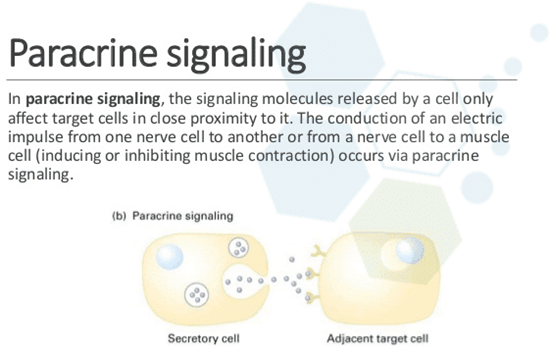Secretions that affect only nearby cells are termed:
Autocrine.
Endocrine.
Exocrine.
Paracrine.
The Correct Answer is D
Paracrine secretions are chemical signals that affect only nearby cells.

They are released by the sending cell and diffuse through the extracellular space to the target cell, which has a specific receptor for the signal.
Paracrine signaling is a form of local signaling that occurs in multicellular organisms.
Choice A is wrong because autocrine secretions are chemical signals that act on the same cell that produced them.
Autocrine signaling is also a form of local signaling, but it involves cell signaling itself.
Choice B is wrong because endocrine secretions are chemical signals that are secreted into the blood and act at long distances.
Endocrine signaling is a form of long-range signaling that involves ductless glands that secrete hormones.
Choice C is wrong because exocrine secretions are non-hormonal substances that are secreted into ducts to the external environment.
Exocrine signaling is not a form of cell-cell communication, but rather a way of releasing substances such as sweat, saliva, or digestive enzymes.
Nursing Test Bank
Naxlex Comprehensive Predictor Exams
Related Questions
Correct Answer is D
Explanation
A person who is stressed usually will have increased blood pressure because stress causes the body to release a surge of hormones that make the heart beat faster and the blood vessels narrow.
This can cause a temporary spike in blood pressure, which usually returns to normal once the stressor is gone.
Choice A is wrong because resistance to infections is not increased by stress.
In fact, chronic stress can weaken the immune system and make a person more prone to infections.
Choice B is wrong because the activity of the spleen and other lymphatic organs is not increased by stress.
The spleen and other lymphatic organs are part of the immune system, which can be affected by chronic stress in a negative way.
Choice C is wrong because the number of lymphocytes in the blood is not increased by stress. Lymphocytes are a type of white blood cell that help fight infections.
Chronic stress can reduce the number and function of lymphocytes and impair the immune response.
Correct Answer is B
Explanation
This is because erythroblastosis fetalis, also known as hemolytic disease of the newborn, is caused by Rh incompatibility between the mother and the fetus.
Rh incompatibility occurs when a Rh-negative mother is impregnated by a Rh-positive father, resulting in a Rh-positive fetus.
The mother’s immune system can detect the Rh factor on the fetus’s red blood cells as foreign and produce antibodies against them.
These antibodies can cross the placenta and destroy the fetus’s red blood cells, causing anemia, jaundice, edema, and other complications.
Choice A is wrong because a second Rh-negative fetus developing in an Rh-negative woman will not cause erythroblastosis fetalis.
The mother and the fetus have the same Rh factor, so there is no immune reaction.
Choice C is wrong because a first Rh-positive fetus developing in an Rh-negative woman will not cause erythroblastosis fetalis.
The mother’s immune system will not produce antibodies against the Rh factor until after the first exposure to it, which usually happens during delivery.
Therefore, the first pregnancy is usually unaffected.
Choice D is wrong because a first Rh-negative fetus developing in an Rh-negative woman will not cause erythroblastosis fetalis.
The mother and the fetus have the same Rh factor, so there is no immune reaction.
The normal range of red blood cell count for newborns is 4.1 to 6.1 million cells per microliter of blood.
The normal range of bilirubin level for newborns is 0.3 to 1.9 milligrams per deciliter of blood.
Whether you are a student looking to ace your exams or a practicing nurse seeking to enhance your expertise , our nursing education contents will empower you with the confidence and competence to make a difference in the lives of patients and become a respected leader in the healthcare field.
Visit Naxlex, invest in your future and unlock endless possibilities with our unparalleled nursing education contents today
Report Wrong Answer on the Current Question
Do you disagree with the answer? If yes, what is your expected answer? Explain.
Kindly be descriptive with the issue you are facing.
